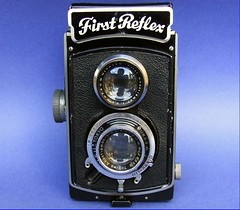First Reflex
The First Reflex is a Japanese 6×6 TLR, made from late 1938 to 1944.[1] It was ostensibly made by First Camera Works but this is certainly only a name used by Minagawa Shōten for advertising purpose. The actual maker was certainly Kuribayashi. The camera was advertised by First Camera Works then by Banno Bōeki.
Contents
Description
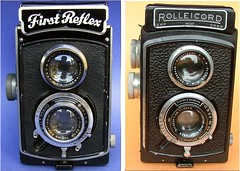 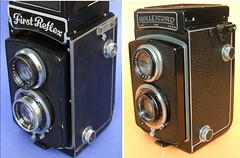
|
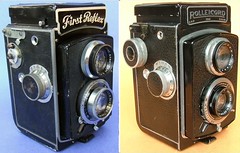 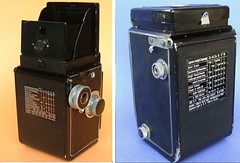
|
| First Reflex vs Rolleicord. Pictures courtesy of Jan Wegrzyn. (Image rights) |

|

|
| First Reflex nameplate and First CAMERA WORKS logo. (Image rights) | |

|

|

|
| Advance knob. (Image rights) |
Viewing hood. (Image rights) |
Back with exposure table. (Image rights) |
The First Reflex is a copy of the 1936 Rolleicord models. The focusing is done by moving the front plate back and forth. The focusing and film advance knobs are on the photographer's right, and the focusing knob is surrounded by a depth-of-field plate. The film advance is semi-automatic, and there is a round exposure counter window at the top of the right-hand side plate.
The nameplate is shaped like the nameplate of the early Rolleicord and is inscribed First Reflex. The viewing hood has a First CAMERA WORKS logo on the front and a magnifying glass hinged to its back. There is also a mirror for eye-level reflex viewing, which is deployed by a small lever situated on the right-hand side of the viewing hood.

|

|
| Taking lens. (Image rights) |
Viewing lens (Image rights) |
The back is hinged to the top and has an exposure table (written in English). This table is exactly identical to that of the Rollekonter, and it seems that these cameras share other parts too. The back also contains a red window, sometimes located under the exposure table and sometimes under the bottom of the camera, used to set the position of the first exposure.
The First Reflex I has 1–300 speeds and a triplet 7.5cm f/3.5 lens whereas the First Reflex II has 1–500 speeds and a four-element 7.5cm f/3.5 lens. (Some sources say that the model II followed the model I but this is apparently a mistake.)[2] It seems that the viewing lens is a 7.5cm f/3.2 on all the models.
Advertisements and other documents
Even if the nameplate on the camera itself reads "First Reflex", the camera was called either "First Reflex" (ファースト・レフレックス, Fāsuto Refurekkusu) or "First Flex" (ファースト・フレックス, Fāsuto Furekkusu) in the advertisements.
The First Reflex was advertised for ¥255 in a special issue of Asahi Camera dated September 1938.[3] It was also featured in the new products column of the October 1938 issue of the same magazine.[4] Some sources say that it was released in 1937 but this is quite dubious.[5] It is said that an early version of the camera received a "First Type-A" shutter made by Kuribayashi and giving T, B, 1–200 speeds, but no such example has been observed so far.[6]
The camera was offered for ¥265 in an advertisement dated January 1939.[7] The lens was mentioned as a Rotte Anastigmat f/3.5 and the shutter as an imported (舶来) N-Compur, reported to have T, B, 1–300 speeds.[8] An advertisement placed in a book about the Semi First dated February 1940 offered the camera with the same Rotte f/3.5 lens and a Seikosha-Rapid shutter to 1/500.[9] This is the oldest occurrence of the Seikosha-Rapid found so far, but it is not sure if the camera was actually sold with that shutter.
The camera was listed in the official price list compiled in October 1940 and published in January 1941, in a single version priced ¥252.[10]

|
| Hit-Rapid shutter. (Image rights) |
Later documents make a distinction between two versions, the First Reflex I (Ⅰ型) with three-element taking lens and 1/300 top speed, and the First Reflex II (Ⅱ型) with four-element taking lens and speeds to 1/500.
The April 1943 government inquiry on Japanese camera production gives the following specifications:[11]
- model I, First 75/3.5 three-element lens, unknown shutter (1–300, T, B);
- model II, Hit 75/3.5 four-element lens, Hit-Rapid shutter (1–500, T, B).
The document says that the First lens and Hit-Rapid shutter were made by Tokiwa Kōgaku.[12] It attributes the Hit f/3.5 lens to Tōkyō Kōgaku, but this is maybe a mistake. Tōkyō Kōgaku is known to have supplied Toko lenses to Kuribayashi for various First cameras, but it seems more likely that the Hit lens and Hit-Rapid shutter were made by the same manufacturer Tokiwa. There is a possibility that the Hit (ヒット) and Hit-Rapid (ヒットラピッド) names were an allusion to Hitler (written ヒトラー or ヒットラー), as for the Hitonar lenses mounted at the same period on the Rollekonter.
An advertisement dated October 1943 by Banno Bōeki gives similar specifications for the model I, offered for ¥340.20.[13] The model II is listed at ¥362 with a Tokiwa f/3.5 four-element lens and 1–500 speeds. The advertising picture shows no difference with the 1939 First Reflex. It is likely that the Hit and Tokiwa lenses were name variants of each other.
An advertisement dated May 1944 by the same distributor shows higher prices: ¥399.20 for the model I and ¥418 for the model II.[14]
Actual examples
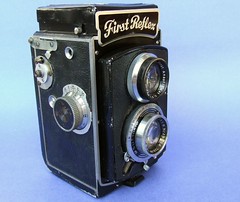 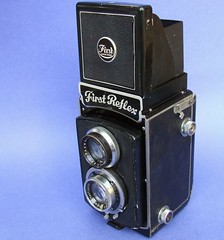 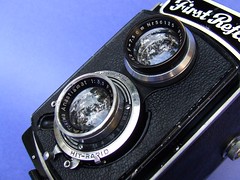
|
       
|
| First Reflex II, Tokiwa Anastigmat 7.5cm f/3.5 taking lens no.28359, First Anastigmat 7.5cm f/3.2 viewing lens no.36125, Hit-Rapid shutter. Pictures courtesy of Jan Wegrzyn. (Image rights) |
| Red window underside. |
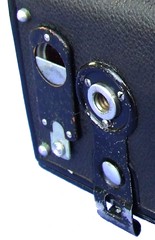
|
| (Image rights) |
The actual examples observed of the First Reflex differ by minor body variations: some have the red window in the middle of the back, just under the exposure table, and others have the red window under the bottom of the camera, on the left-hand side.[15] At least one example has a round button at the back of the viewing hood, to the right of the magnifying glass, whose use is unknown.[16]
The observed lens and shutter combinations are the following:
- First Anastigmat taking lens, unmarked shutter, T, B, 1–300 speeds (First Reflex I);[17]
- Hit Anastigmat taking lens, probably First Anastigmat viewing lens, Hit-Rapid shutter, T, B, 1–500 speeds (First Reflex II);[18]
- Tokiwa Anastigmat taking lens, First Anastigmat taking lens, Hit-Rapid shutter, T, B, 1–500 speeds (First Reflex II).[19]
The Hit-Rapid shutter is marked HIT–RAPID on the speed rim and MSU–TOKYO on the shutter plate. The initials "MSU" might possibly stand for Minagawa Shōten Ueno, but this is unconfirmed.[20]
- Ferst Anastigmat f3.5/75mm taking lens, Ferst Anastigmat f3.5/75mm viewing lens, Lustre-Rapid shutter, B, 1–500 speeds.[21]
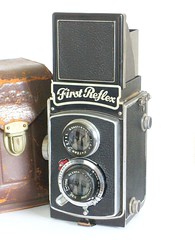  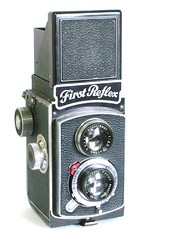
|
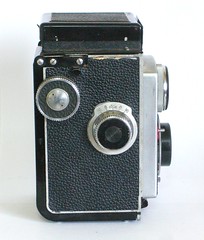  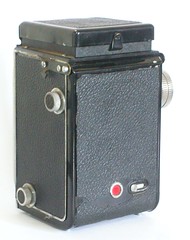
|
| Kuribayashi First Reflex ,Lustre-Rapid shutter, Ferst Anastigmat f3.5/75mm taking lens. Images by yalluflex. (Image rights) |
Notes
- ↑ Dates: advertisements and articles listed in Kokusan kamera no rekishi, p.340.
- ↑ Baird, p.105; McKeown, pp.577–8.
- ↑ Advertisement published in the supplement for the 150th issue of Asahi Camera, observed in an online auction.
- ↑ Kokusan kamera no rekishi, p.340.
- ↑ Baird, pp.20 and 102; McKeown, p.577.
- ↑ Baird, pp.20 and 105, quoting a letter by a former employee of Petri.
- ↑ Advertisement published in Asahi Camera, reproduced in Kokusan kamera no rekishi, p.88. The same advertisement is reproduced in Furukawa, p.22 of Camera Collectors' News no.277.
- ↑ Shutter speeds: Kokusan kamera no rekishi, p.340.
- ↑ Advertisement placed in Semi Fāsuto no tsukaikata (User guide to the Semi First), reproduced in Furukawa, p.26 of Camera Collectors' News no.277. The date of publication of the book is curiously given as February 30, 1940.
- ↑ "Kokusan shashinki no kōtei kakaku", type 7, section 1.
- ↑ "Kokusan shashinki no genjōchōsa" ("Inquiry into Japanese cameras"), items 112–3, lens items Lb18 and Lb38, shutter items 18-P-12 and 18-R-1. Baird, p.25, says that the First lenses were made by Miyoshi, but all the 1943 inquiry attributes all of them to Tokiwa.
- ↑ Baird, p.25, says that the First lenses were made by Miyoshi, but all the 1943 inquiry attributes all the First lenses to Tokiwa.
- ↑ Advertisement published in Shashin Bunka, reproduced in Kokusan kamera no rekishi, p.88.
- ↑ Advertisement published in Shashin Kagaku, reproduced in Kokusan kamera no rekishi, p.88.
- ↑ Red window in the back: example pictured in Baird, pp.102–6. Red window under the bottom: example pictured in McKeown, p.577, example observed for sale at a Chinese dealer and example observed in an online auction.
- ↑ Example pictured in McKeown, p.577.
- ↑ Example observed for sale at a Chinese dealer.
- ↑ Example pictured in Sugiyama, item 2007, and example pictured in McKeown, p.578.
- ↑ Examples pictured in this page at tlr-cameras.com. It is extremely likely that the example with reversed taking and viewing lens names had its lenses swapped at some time. It seems that this lens and shutter combination also equips the example pictured in Baird, pp.102–6.
- ↑ Suggestion by Dirk HR Spennemann.
- ↑ Example pictured on this page by Flickr member yalluflex, notice the use of Ferst instead of First in the lensname.
Bibliography
- Asahi Camera (アサヒカメラ) editorial staff. Shōwa 10–40nen kōkoku ni miru kokusan kamera no rekishi (昭和10–40年広告にみる国産カメラの歴史, Japanese camera history as seen in advertisements, 1935–1965). Tokyo: Asahi Shinbunsha, 1994. ISBN 4-02-330312-7. Items 214–6.
- Baird, John R. Collectors guide to Kuribayashi-Petri Cameras. Grantsburg, WI (USA): Centennial Photo Service, 1991. ISBN 0-931838-16-9. Pp.20 and 102–6.
- Furukawa Haruo (古川保男). "Bebī Semi Fāsuto 'Kore ha bebī wo nanotta semi-ki da'" (ベビーセミファースト"これはベビーを名乗ったセミ機だ", Baby Semi First, this is a Semi camera called Baby). In Camera Collectors' News no.277 (July 2000). Nishinomiya: Camera Collectors News-sha. Pp.19–27.
- "Kokusan shashinki no genjōchōsa" (国産写真機ノ現状調査, Inquiry into Japanese cameras), listing Japanese camera production as of April 1943. Reproduced in Supuringu kamera de ikou: Zen 69 kishu no shōkai to tsukaikata (スプリングカメラでいこう: 全69機種の紹介と使い方, Let's try spring cameras: Presentation and use of 69 machines). Tokyo: Shashinkogyo Syuppan-sha, 2004. ISBN 4-87956-072-3. Pp.180–7. Items 112–3.
- "Kokusan shashinki no kōtei kakaku" (国産写真機の公定価格, Set prices of the Japanese cameras), listing Japanese camera production as of October 25, 1940 and setting the retail prices from December 10, 1940. Published in Asahi Camera January 1941 and reproduced in Shōwa 10—40nen kōkoku ni miru kokusan kamera no rekishi (昭和10〜40年広告にみる国産カメラの歴史, Japanese camera history as seen in advertisements, 1935—1965). Tokyo: Asahi Shinbunsha, 1994. ISBN 4-02-330312-7. Pp.108—9. Type 7, section 1.
- Lewis, Gordon, ed. The History of the Japanese Camera. Rochester, N.Y.: George Eastman House, International Museum of Photography & Film, 1991. ISBN 0-935398-17-1 (paper), 0-935398-16-3 (hard). Pp.39 and 54 (brief mentions only).
- McKeown, James M. and Joan C. McKeown's Price Guide to Antique and Classic Cameras, 12th Edition, 2005-2006. USA, Centennial Photo Service, 2004. ISBN 0-931838-40-1 (hardcover). ISBN 0-931838-41-X (softcover). Pp.577–8.
- Sugiyama, Kōichi (杉山浩一); Naoi, Hiroaki (直井浩明); Bullock, John R. The Collector's Guide to Japanese Cameras. 国産カメラ図鑑 (Kokusan kamera zukan). Tokyo: Asahi Sonorama, 1985. ISBN 4-257-03187-5. Item 2007.
Links
In English:
- First Reflex and Firstflex TLR cameras at Barry Toogood's tlr-cameras.com (with pictures of the First Reflex)
| Kuribayashi prewar and wartime cameras () | ||||
|---|---|---|---|---|
| rollfilm folders | ||||
| Eagle | Speed Pocket | First Roll | First Center | Semi First | First Six | Baby Semi First | Semi Rotte | Hokoku | Mizuho | ||||
| plate folders | rigid | SLR | TLR | unknown |
| Mikuni | First | First Etui | Kokka | Romax | Tokiwa | Molby | Speed Reflex | First Reflex | Baby First |
